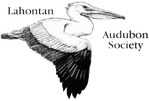|
by Bob Goodman
Timing is everything. As I turned my vehicle around to view Nest #1068, there were four American Ospreys in aerial combat over and around the nest site. Their distinctive calls were loud and continuous. In my many years of involvement with this species, I had never witnessed such aggressive behavior. None of the four birds had any human-induced markings, as bands or jesses, so I couldn't tell if the returning pair that had used this site was winning or losing to the interlopers. But, there was a winning pair that after many minutes of combat, settled on the edge of the platform. The other pair, as in any good movie, flew off towards the sun. Nest #1068 is just one of many osprey nests I have been monitoring since 2011 around Lake Davis and Frenchman Corridor in California. A more recent nest, #5204, is near Verdi along the Truckee River, and has been active for the past three years. Just to give an idea of how many nests are being monitored, two newly located nests this season are #6269 and #6270. These numbers are assigned by an organization sponsored by the College of William and Mary, an international repository for the Osprey Watch Program, Center for Conservation Biology. I first learned of them in 2011, and became interested because I had conducted first nest surveys of osprey, then initiated a banding program with them in North Idaho, Western Montana and Eastern Washington in 1968. It just seemed like a good idea to keep involved. Today, the Osprey Watch program has 2,365 “watchers” covering 6,014 active nests all across the northern hemisphere of North America and Europe, and one in New Zealand. Although the numbering of nests is now higher, the lower figure, 6,014, is the nests that have been active this nesting cycle. Other nests may have fallen down, or been abandoned over the years. When I was first involved in the 1960's, the American Osprey was listed as “undetermined status” as the scientific community wasn't sure if the population was increasing or declining. This, of course, followed the collapse of the species, most noticeably in Chesapeake Bay that went from 400 nests to 40 following the introduction of DDT. This time around, the program is looking at the American Osprey once again as an indicator species of what is going on in the aquatic ecosystem. This includes all waters, as oceans, lakes, rivers, and bays, and this time the scientific community is also looking at the effects of global warming, depletion of fish stocks, and environmental contaminants in these waters. The osprey is well-suited for these tasks, as this species is a top consumer in the aquatic ecosystem. Also, all populations of osprey breed in the northern hemisphere, and overwinter in the southern hemisphere. This makes the species a truly global monitor species for the three concerns. What does the monitoring program involve? Quite simply, one checks for active nests in the spring of the year, when the osprey may be returning from their wintering grounds around the Sea of Cortez, the Baja Peninsula, or the northern tier of South American countries. This can be as early as March for the first to return, to much later for others. At this time, old nest sites are checked as some may have been lost over the winter due to a variety of factors, and activity for any new nest building noted. If possible, the number of eggs that are laid will be noted, then the number of these that actually hatch. Following progress of the family can be difficult, as in my case as the nests are all very high, a long ways off, or the nest wells are too deep to see into during the early stages. In Idaho, I climbed the nest structures to do these counts, but those days are gone. Now, since I have had many years of noting nesting activities, I can tell what the adults are doing and have a good guess as to the nest contents. In other parts of their habitat the nests are much easier to see into for these counts. Keeping track of the number of eggs hatched, the number of young produced at this point, and the number that make it through to fledgling are the important numbers that are meaningful from this global network. Over the six years of observations here the osprey have produced an average of two young per pair. The low count was one, and the high count was four young at a nest by Coot Bay at Lake Davis. At Lake Davis, there are interesting actions taking place between the ospreys that have traditionally built nests and raised families around the lake, and Bald Eagles that have tried to take over these nests, and have successfully done so on occasion. This year an osprey nest has, for the second time in four years, been taken over by the eagles that are now raising two young. As a side benefit of doing these surveys, one can learn a lot about the natural history of a species. |
topics
All
Archives
July 2024
|


 RSS Feed
RSS Feed